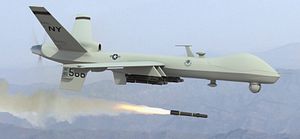The U.S. Air Force (USAF) is slated to receive 30 additional General Atomics Aeronautical Systems MQ-9 Reaper unmanned aerial vehicles (UAVs) under a $370.9 million contract, the U.S. Department of Defense announced on August 15. All of the UAVs are expected to be delivered to the USAF by May 2019. The USAF will use 2014 and 2015 aircraft procurement funds to pay for the additional drones.
As of September 2015, the USAF has an inventory of 93 Reaper UAVs, according to a USAF fact sheet. In 2015, the USAF announced that it would retire the General Atomics Aeronautical Systems MQ-1 Predator – the USAF’s principal weapon of choice in UAV airstrikes – by 2019. As a consequence, the USAF is interested in adding new UAVs to its burgeoning drone arsenal.
The MQ-9 Reaper is first and foremost used for remotely striking enemy targets. “The MQ-9 Reaper is an armed, multi-mission, medium-altitude, long-endurance remotely piloted aircraft that is employed primarily against dynamic execution targets and secondarily as an intelligence collection asset,” the fact sheet notes. The USAF’s fleet of Reapers is currently controlled out of Creech Air Force Base in Nevada.
“Given its significant loiter time, wide-range sensors, multi-mode communications suite, and precision weapons — it provides a unique capability to perform strike, coordination, and reconnaissance against high-value, fleeting, and time-sensitive targets,” the fact sheet adds. The UAV can be armed with up to four laser-guided, Air-to-Ground Missile (AGM)-114 Hellfire missiles.
Two MQ-9 Reaper UAVs have also recently demonstrated the ability to track enemy missiles during a multilateral ballistic missile defense training exercise, which also involved Aegis destroyers from the United States, South Korea, and Japan (See: “US, Japan, South Korea Conduct Joint Missile Drill”).
The U.S. military currently faces a shortage in drone pilots; the USAF is expecting to add 334 new pilots in 2016. As I reported previously (See: “Pentagon to Increase Drone Flights Over South China Sea”), the Pentagon has been working on a new plan to increase the number of UAV flights in the next three years:
In detail, the new plan envisions an increase in the number of flights from 61 to 90 by 2019. The majority of missions are currently flown by the U.S. Air Force (USAF). However, in addition to around 60 USAF flights, the new plan foresees as many as 16 sorties flown by the U.S. Army, up to four by the Special Forces Command, and around ten by government contractors. The USAF currently shares intelligence feeds from 22 out of its 60 daily sorties with the Central Intelligence Agency.
Back in October 2014, U.S. Defense Secretary Ashton Carter reduced the number of drone flights from 65 to 60 due to overworked USAF pilots and crews on the condition that the Pentagon would eventually increase its drone capability outside the USAF. The result was a plan that will gradually increase the role of other service branches as well as government contractors. By 2017, the U.S. Army is supposed to supply eight and government contractors six daily flights.
The USAF currently flies 60 combat sorties per day. This number is expected to be increased to 70 by the end of the year. The U.S. Army is flying ten combat air patrols per day, according to the Air Force Times. Since 2004, the United States has conducted 424 drone strikes in Pakistan and between 404 and 409 strikes in Afghanistan, with an estimated 4,472 to 6,506 casualties in both countries, according to The Bureau of Investigative Journalism.

































